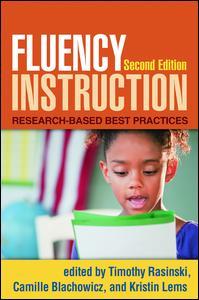Fluency Instruction, Second Edition (2nd Ed.) Research-Based Best Practices
Coordonnateurs : Rasinski Timothy, Blachowicz Camille, Lems Kristin

This accessible guide brings together well-known authorities to examine what reading fluency is and how it can best be taught. Teachers get a clear, practical roadmap for navigating the often confusing terrain of this crucial aspect of balanced literacy instruction. Innovative approaches to instruction and assessment are described and illustrated with vivid examples from K-12 classrooms. The book debunks common misconceptions about fluency and clarifies its key role in comprehension. Effective practices are presented for developing fluency in specific populations, including English language learners, adolescents, and struggling readers. New to This Edition *Reflects advances in fluency research and the ongoing development of exemplary instructional approaches. *Three new chapters on English language learners. *Chapters on adolescent fluency, reading expressiveness, oral reading instruction, and text selection.
I. Fluency Theory, Fluency Research 1. Reading Fluency: Its Past, Present, and Future, S. Jay Samuels 2. Developing Fluency in the Context of Effective Literacy Instruction, Timothy Shanahan 3. Reading Expressiveness: The Neglected Aspect of Reading Fluency, Paula J. Schwanenflugel and Rebekah George Benjamin 4. The Importance of Adolescent Fluency, David D. Paige 5. Reading Fluency Revisited: Much More Than Fast and Accurate Reading, Barbara J. Walker, Kouider Mokhtari, and Stephan Sargent 6. Fluency: The Link between Decoding and Comprehension for Struggling Readers, David J. Chard, John J. Pikulski, and Sarah H. McDonagh 7. "Hey Teacher, When You Say ‘Fluency,’ What Do You Mean?": Developing Fluency in Elementary Classrooms, D. Ray ReutzelII. Best Programs, Best Practices 8. Battling on Two Fronts: Creating Effective Oral Reading Instruction, Melanie R. Kuhn, Gwynne E. Ash, and Megan Gregory
9. "Jonathon Is 11 but Reads LikeaStruggling 7-Year-Old": Providing Assistance for Struggling Readers with Audio-Assisted Reading Programs, Meryl-Lynn Pluck
10. The Fluency Development Lesson: A Model of Authentic and Effective Fluency Instruction, Belinda Zimmerman and Timothy Rasinski 11. Paired Reading: Impact of a Tutoring Method on Reading Accuracy, Comprehension, and Fluency, Keith J. Topping 12. "Everybody Reads": Fluency as a Focus for Staff Development, Camille L. Z. Blachowicz, Mary Kay Moskal, Jennifer R. Massarelli, Connie M. Obrochta, Ellen Fogelberg, and Peter Fisher 13. Hijacking Fluency and Instructionally Informative Assessments, Danielle L. Dennis, Kathryn L. Solic, and Richard L. AllingtonIII. Special Topics, Special Populations 14. Teaching Fluency (and Decoding) through Fast Start: An Early Childhood Parental Involvement Program, Timothy Rasinski, Nancy Padak, and Bruce Stevenson 15. Reading Fluency and Comprehension in English Language Learners, Kristin Lems 16. Fluency Instruction in Reading in a Second or Foreign Language, Etsuo Taguchi and Greta Gorsuch 17. Fluency Scores of English Language Learners: What Can They Tell Us?, Becky McTague, Kristin Lems, Dana Butler, and Elsa Carmona 18. Curious George and Rosetta Stone: The Role of Texts in Supporting Automaticity in Beginning Reading, Elfrieda H. Hiebert
19. Building a Focus on Oral Reading Fluency into Individual Instruction forStruggling Readers, Jerry Zutell, Randal Donelson, Jessica Bevans, and Patsy Todt
Timothy Rasinski, PhD, is Professor of Literacy Education at Kent State University. His scholarly interests include reading fluency and word study, reading in the elementary and middle grades, and readers who struggle. Dr. Rasinski has received the A. B. Herr and Laureate Awards from the College Reading Association and is an elected member of the International Reading Hall of Fame.
Camille Blachowicz, PhD, is Research Professor at National Louis University, where she has directed the Reading Specialist Program and the Reading Center. Her research and publications focus on vocabulary and comprehension instruction and on working with at-risk readers. Dr. Blachowicz was a Fulbright Scholar in Italy and is Co-Principal Investigator of the federally funded Multiphase Comprehensive Vocabulary Instruction Project.
Kristin Lems, EdD, is Professor of English as a Second Language/Bilingual Education at National Louis University, where she teaches graduate courses for practicing teachers. She has published a number of books, chapters, and articles in both the ESL and reading fields. Dr. Lems was a Fulbright Scholar in Algeria for 2 years and is an English Language Specialist with the Office of English Language Programs at the U.S. State Department.
Date de parution : 06-2012
Ouvrage de 348 p.
15.2x22.9 cm
Date de parution : 06-2012
Ouvrage de 348 p.
15.2x22.9 cm



